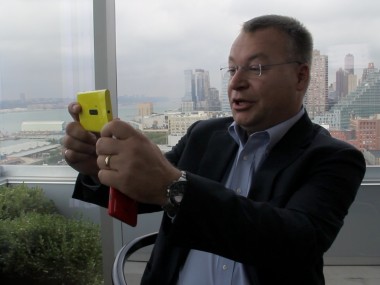Saying that today is a big day for the Finnish wireless concern Nokia is putting it lightly. With its shares trading at levels not seen since the mid 1990s, and its once-dominant position atop the world market for wireless phones shattered, Nokia has placed a huge bet on a software partnership with Microsoft.
Today, the company announced two new phones, the Lumia 920 and Lumia 820, the latest in its line of smartphones running Microsoft’s Windows Phone operating system. Their key features: New cameras designed to eliminate blurriness and improve image quality in low light conditions; big, bright displays; and wireless charging. It is, in many ways, a reintroduction of the Nokia brand to North America, territory that has become more or less dominated by Apple’s iPhone and phones using Google’s Android operating system.
Nokia CEO Stephen Elop sat down with AllThingsD for a few minutes today to talk about the new phones, and the company’s strategy going forward.
AllThingsD: So, Stephen, Nokia is releasing two new smartphones today. Let’s start there. What’s special about these phones?
Elop: Let me give you a little context. You may recall that back in February of 2011 we announced a pretty significant shift in Nokia’s strategy. And that included the partnership with Microsoft, it included a new focus on what we call mobile phones, which are the lower-priced devices and sold primarily in emerging markets, and also on what we call future disruptions, like what comes next, research and innovation. Then, in October of last year, we introduced the first Lumia phones, the first Windows Phone-based Nokia products. Today is the next big step in that journey with Microsoft. We’ve introduced the Lumia 920 and the Lumia 820.
The first thing I notice here are the displays. They’re pretty big and pretty bright.
Just to give you a sense of these devices, they have big, bright displays, but they also react uniquely under direct sunlight. So, through polarization and special brightening capabilities, you can stand out in direct sunlight and continue to use your device. Or if it’s winter, and you happen to be someplace cold, and you have gloves on, the screen responds to gloves, it responds to fingernails. It’s a very sensitive touch display. But the other feature that makes us confident about this phone is that we think it will enable people to take the best photos. I suspect from the device you have on your lap (an iPhone), you’ve probably taken a few thousand pictures in low light conditions, at night, where it’s a bit blurry, or the flash blasts out the face. Our PureView technology, which is a unique Nokia capability, in the Lumia 920, we’ve built a unique sensor and lens capability that is floating.
What do you mean by “floating”?
Mechanically, it moves. So to counterbalance the movement of your hand, or you’re walking down the street or in a car taking a picture, the lens is moving to counterbalance your movements. And we have unique software on the device that interprets it all to give you amazing images. In low light conditions, the hand-shaking is a big problem because it leads to blurry images.
So I take it that the camera’s capabilities are going to be a key feature you use in marketing?
Absolutely. Because when you talk to consumers, they say they’re taking blurry images with their phones all the time. Now you can hold the phone up in that concert and get a beautiful image, or of the kids at a soccer game. Now it goes further than that. This type of camera technology and the screen, they both take a lot of power, so we have a very large battery. But the other thing we have is wireless charging. You can set the phone down on a wireless charging platform, and it charges.
Is this Nokia-built charging technology, or did you license this from someone else?
We’re using a wireless charging technology standard called Qi (pronounced “chee”) in a lot of these technologies. We want to drive the standard. There’s also a very fashionable brand in Europe known as Fatboy; they make beanbag chairs, so now there’s a beanbag chair that charges your phone.
These phones are Windows Phone 8. Will we be seeing any Windows 7.8 devices?
We’re not announcing any today, but the statement we have made is that we will continue to sell devices with that software, and we’ll continue to upgrade them. For example, the start screen with the newly sized icons, those will start to show up on the existing Lumia devices as well. So some of those devices will continue to be sold. We may introduce some new ones, but we haven’t announced any yet.
It seems like the Windows phone market is growing for Nokia, but not fast enough to offset the declines in the Symbian and other lines. How do you plan to address that?
We don’t think about it as one offsets the other. We have to grow, and it is our intention with these devices to grow the number of Windows Phone devices that are out there, and to grow our market share as it relates to the smartphone segment. But at the same time, the other parts of our business, the mobile phone business in volume, it grew quarter on quarter. So there’s an opportunity to continue to grow a market that’s been very good to us.
Microsoft has Surface coming, which puts them in the hardware business. It has yet to say it is going to build its own phone, and Nokia hasn’t spoken of a tablet. But there’s a lot of potential for both of you there to make some moves. In that eventuality, what do you think of the prospect of competing with your most important partner?
It is the case that these relationships are complicated. Now, we haven’t announced a tablet, but if we were to do so, it would be competitive with whatever Microsoft does. That’s okay. I’ll use another example: Samsung. We compete directly with them on smartphones. They are, at the same time, one of our largest suppliers. And so you have different meetings with them at different times of the day. And that’s okay. These relationships are so complicated, you can be competing in one segment of the market and doing business with them in another. And that’s okay.
Via: All Things D
More: The Verge, FierceWireless, Evolver.fm, The Verge and Engadget













